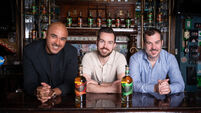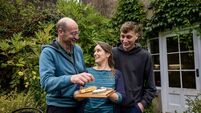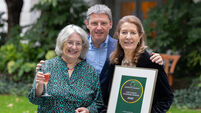True blue: How Cashel Farmhouse's iconic Cashel Blue cheese has stood the test of time
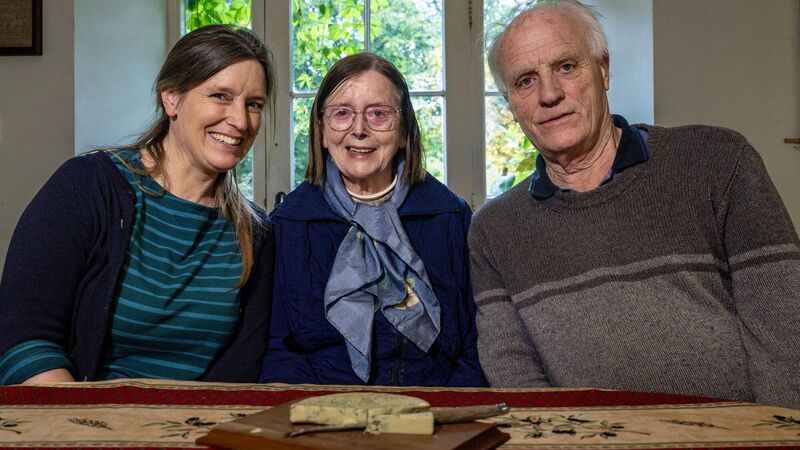
Inside the original farmhouse kitchen, where Cashel Blue was first made in saucepans on the stove, Sarah Furno joins her parents Jane and Louis at the old table with a slice of the cheese before them. Picture: Chani Anderson
Jane and Louis Grubb, their daughter Sarah, and Sarah’s husband Sergio Furno are freshly crowned as Best Artisan Producers at the Blas na hÉireann 2025 food awards.
It is yet another prestigious award to add to a collection accrued over the decades since 1984 when they first launched one of Ireland’s iconic cheeses, Cashel Blue, but they are still in the dark about this impending accolade when I visit several weeks before.
We don the gear: Polypropylene coats and hairnets, plastic shoe covers, and, for me, a beard net.
Washing our hands in disinfectant soap, we leave the ‘real world’ for the sterile inner sanctum of the ultra-modern dairy facility.
Inside the first chamber, elevated gantries run around large stainless steel vats where the cheesemaking process begins.
Milk is heated to around 34C, starter culture and blue mould (penicillium Roqueforti) are stirred in to begin the transformation process.
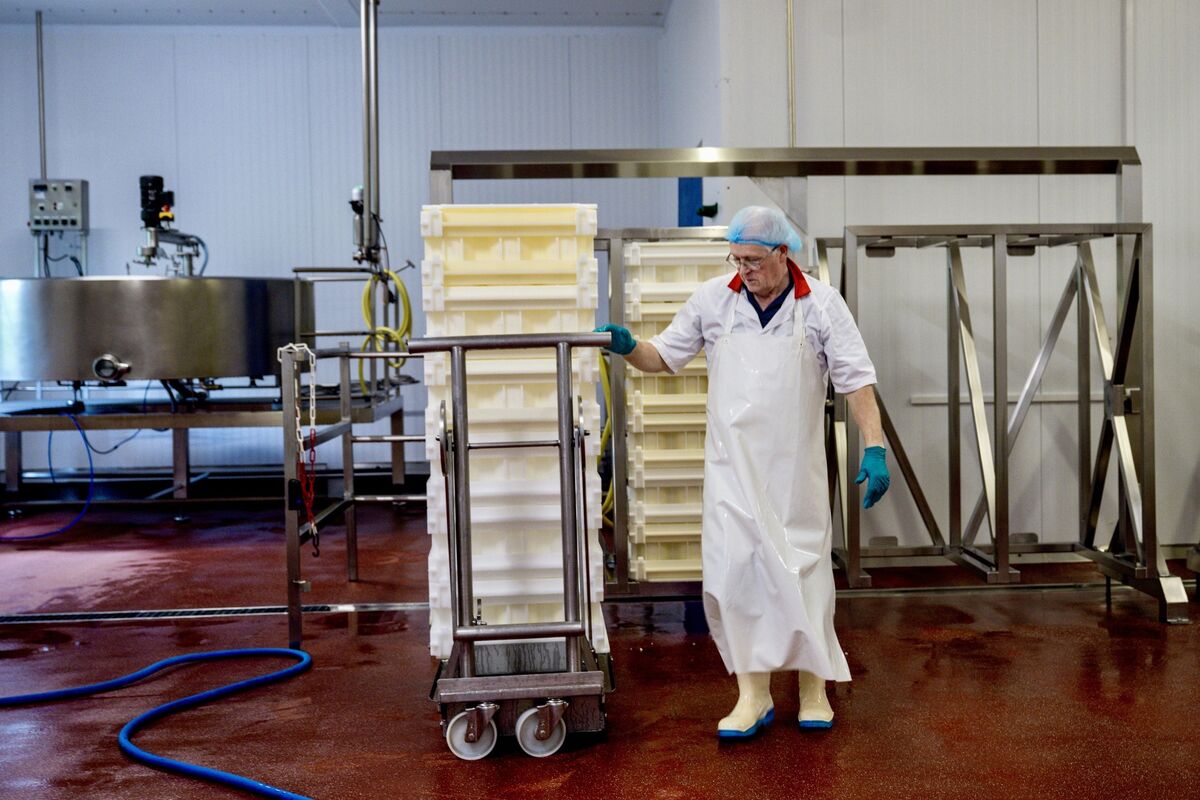
Then follows the rennet to set the milk, coagulating it into curds which rest for a spell before being cut into smaller curds.
As whey is drained away, curds are then transferred to another hulking stainless steel machine, which then injects the curds into plastic moulds.
From there, we step into a high-ceilinged corridor where crates of filled moulds, stacked head high, are encased in stainless steel cages running all the way down on either side, automated to turn every hour to drain the pressed curds.
Our final stop is the refrigerated cheese room, another high-ceilinged chamber where temperature hovers around 6C.
I have been in plenty of cheese rooms, always finding the odours compelling, but have never encountered anything like the aroma here; where other cheese rooms carry that sharp funk of fermentation, ranging from sweaty saddle to damp plaster and points between, here the aroma is vanilla sweet, like creme caramel, as any remaining lactose is consumed by the blue mould and the creamy yellow rounds mature into world-renowned Cashel Blue and its more exclusive sibling, Crozier Blue.
It is a mightily impressive operation, sleek, shining, modern, befitting the largest Irish farmhouse cheese business in the country, producing 400 tonnes of cheese annually and exporting all over the world, including to France.
It is even more impressive when you consider it began just over 40 years ago, in Jane Grubb’s kitchen, before moving into a scruffy old stable in the courtyard alongside the family home, and where cheesemaking equipment, scavenged from scrap, included knitting needles, off-cuts of Wavin pipe, unbleached linen from a drapery in Charleville, and a salvaged old steel and copper pot that now takes pride of place in the visitors’ centre.
“Making cheese was my idea,” says Jane Grubb. “We got very frustrated in the early ’80s, milking cows for milk that just went into the butter mountain, and we had to think of alternatives. Originally, we thought of ice cream but it was such a limited market then and seasonal. We went to Avonmore [today’s giant dairy co-op then a much smaller enterprise] and they were very helpful. I went to a course of cheesemaking in Lavistown, in Kilkenny, and did a beginner’s course. The following day, I did advanced.”
Jane’s first experiments began in 1982, using a large copper jam preserving pan on her big gas stove. Those initial efforts resulted in hard cheeses: A Cheshire, called Fethard, then a Caerphilly, called Ballingarry, eight cheeses at a time which she sold in Fethard country market.
It was only when she moved out to the stable that Cashel Blue was born. Moulds to shape the cheese were fashioned from old drainage pipes with holes drilled into them and sealed at the ends with unbleached linen.
“We used to buy scrim, raw linen, from Charles Murray’s, in Charleville,” says Jane, “the only place you could get it at the time.”
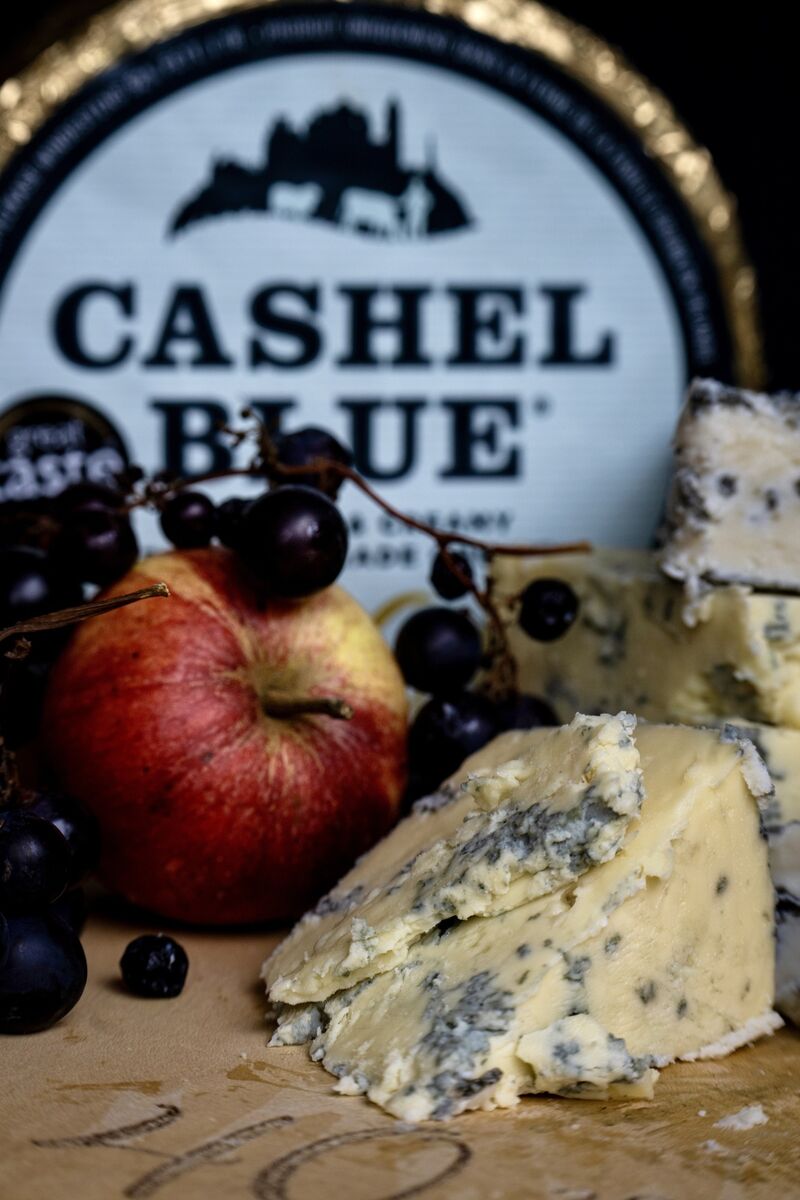
Blue cheese has to be multiply pierced through to allow in air to aid the work of the blue mould, to encourage the flourishing of those filigree seams of penicillium running through the cheese like marbling.
Each cheesemaker closely guards their ratio of piercings and the Cashel formula has remained essentially the same since early on.
“We had an old machine, again made from scrap, you’d pull the lever down and there was a disk with stainless knitting needles. Originally, I used to poke the cheeses with a cork disk with needles on the end. It worked.”
The first markets, other than local country markets, were specialised delis around the country, including Horgan’s, The Traditional Cheese Co, Peter Ward’s Country Choice, in Nenagh, McCambridges, in Galway.
Their first hospitality customer was Myrtle Allen, in Ballymaloe House, for whom a younger Jane — born in Dublin and trained as a chef in Cathal Brugha St — worked earlier in her career.
She long had a reputation for supporting the early Irish farmhouse cheesemakers.
But the first real major recognition that Cashel Blue was pretty special came when it won first prize in the prestigious national cheese competition at the Clones Agricultural Show, in Monaghan, in 1984, the same year that this, the first Irish farmhouse blue cheese, came to market.
“That was really the start of it,” says Jane. “Yeah,” says Louis, “that was the first time it was recognised.”
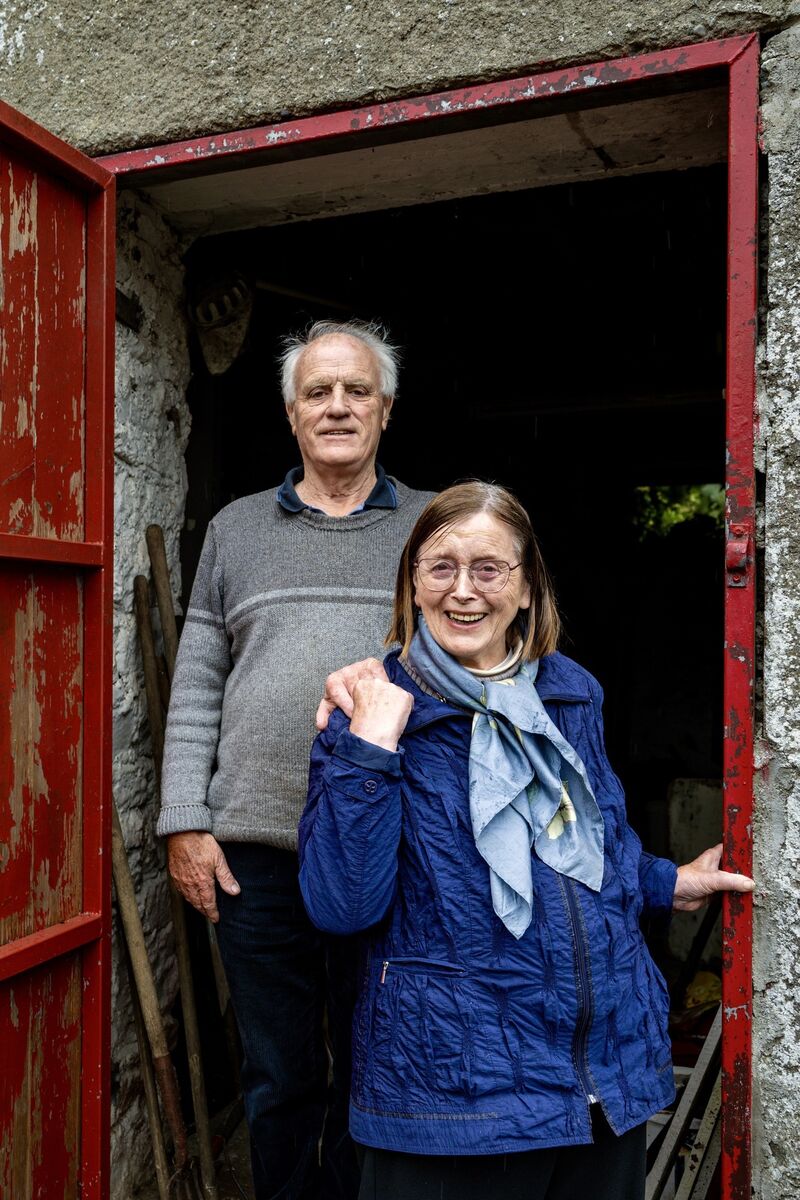
After a few years, in what Louis calls a “critical point”, the Grubbs turned to cheesemaking full time, employing a farm manager, allowing them to develop the cheese.
“In 2011, says Sarah, “I met a Dutch judge at the French Salon de Fromage who had judged Cashel in competition in the RDS, around ’85, ’86. ‘It’s really improved,’ he said.”
It was around the mid-’80s that Cashel Blue began to make waves internationally, beginning in competition in England, and its rise around the world has continued to this day.
“There was also an article in the New York Times quite early on,” recalls Louis.
“I went to university in Wales [where she met her husband, Sergio],” says Sarah, “I remember visiting a friend in Bristol just after finishing and — remember, this was before the internet and it wasn’t as easy to get around Europe and Mum and Dad were busy on the farm and with the cheesemaking — and I was sitting in her house and she was really into cooking. I opened up [Nigella Lawson’s] Domestic Goddess [cookbook] and saw a scone recipe with Cashel Blue. Then in 2002, [UK TV chef] Gary Rhodes said it was his favourite cheese in the world, which me and Sergio thought was very cool. Gordon Ramsay was another supporter and, in the late ’90s, [TV chef] Delia Smith was plugging it as well in one of her early books.”
It wasn’t always a foregone conclusion that Sarah, Louis and Jane’s only child, would join the family business.
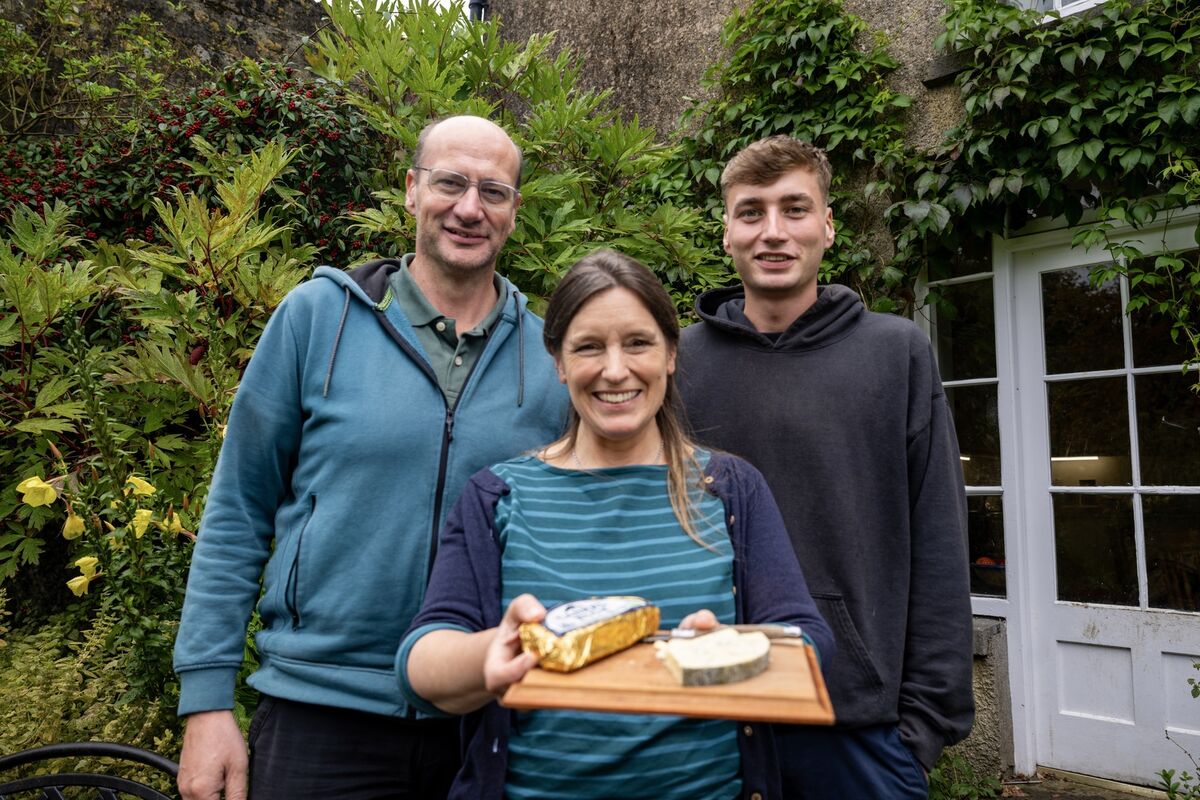
She and Sergio lived and worked in France, Italy, and Britain for a number of years and had been intending on starting a wine-importing business in Ireland when they made the decision to get involved, in 2003.
Sarah says: “At the time, we would have been holding a stock of 3,000 cheeses... the figure is now 60,000. Back then most Cashel Blue was released when it was between three and six weeks old, and I started developing a grading and ageing programme, taking a lot of our skills from the wine industry, we could see such versatility in Cashel. We really wanted to bring it up to what it could be — and that takes time — actually put the conversation around taste. You look back to some of my early notebooks on that. They’re very different to how they are today.
“Also, I really wanted to develop the French market. Sergio and I lived and worked in France and in Italy, and we’ve lots of French friends. And everyone had always said ‘Oh, we love Cashel. Why don’t you sell in France?’ And then there was an opportunity to have a postgraduate student working through a government programme, in foreign markets on a part-time basis, and we said we’d give it a go.
“We found an Irish woman in Paris, Clara Marie Tracy, in 2011 — she was a great character. She arrived at the first tasting in a summer frock and was freezing so she turned up at the next in a ski suit with a bottle of Irish whiskey tucked under her arm, and they loved her. Today we work with many distributors in France and it is extremely widely available in independent stores all over Paris and France generally.”
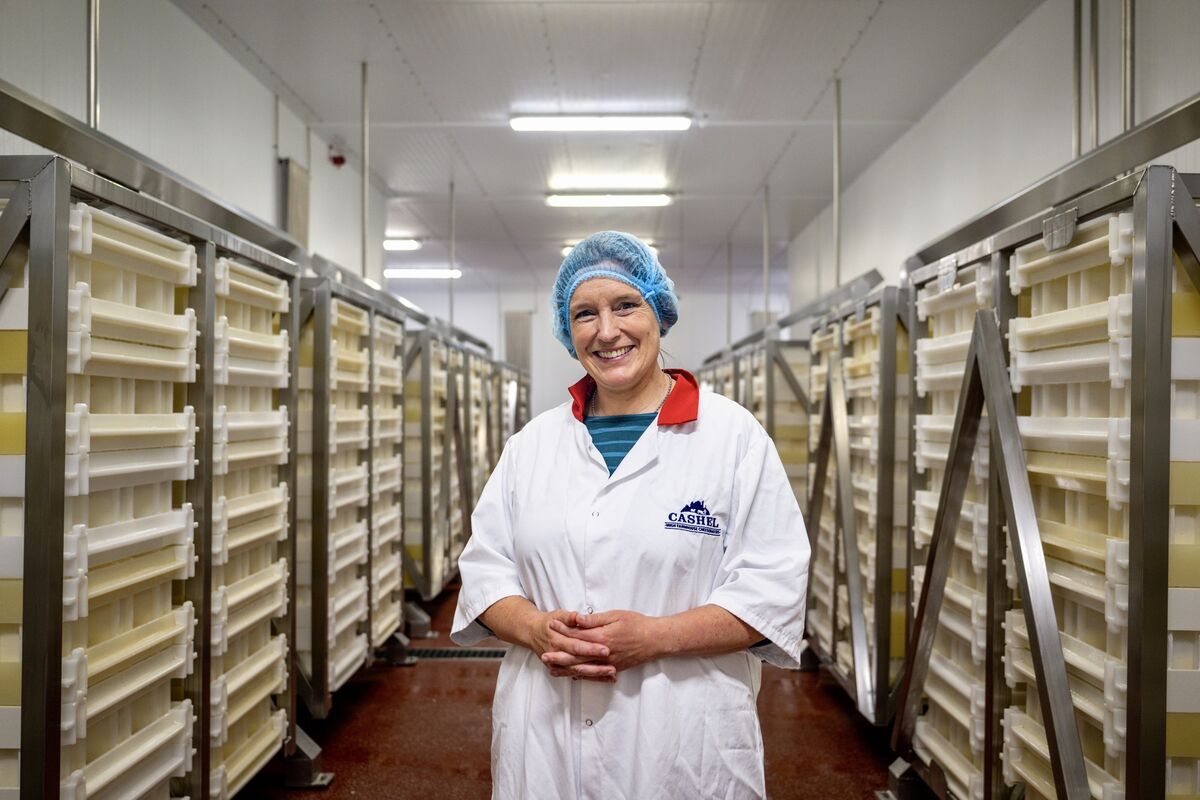
There are now 400 tonnes of Cashel Blue made each year, 65% sold in Ireland and the rest exported, mainly to Britain, France, North America, and Australia, with shipments also going to Japan, Italy, Spain, Belgium, and Netherlands.
“Thankfully [since Trump’s tariffs], not as much to the US anymore [where it is marketed as Kerrygold Cashel Blue, in a commercial arrangement with the iconic Irish butter company] — in 2003, 25% of all of our production was going to the States.
The UK was 21% of our market before Brexit, then slipped to 14% but it’s slowly growing again, but I don’t have a huge amount of confidence in the UK market — I don’t think the UK consumers are confident.”
Their sheep’s milk cheese, the sublime and rarified Crozier Blue — this writer’s preferred choice of the two cheeses — is only sold in Ireland; the supply of Irish sheep’s milk is too small to support an international sales drive.
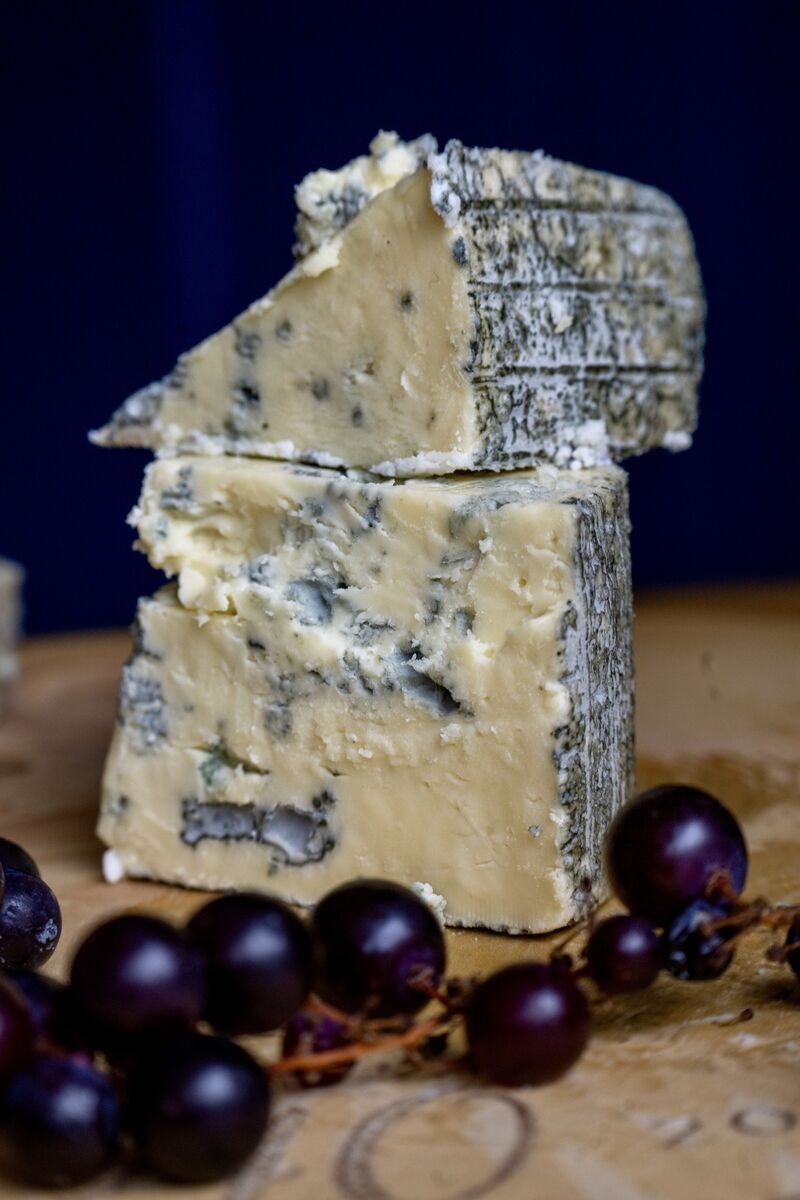
The Grubbs were Quakers who fled to Ireland in the 1700s and have been deeply embedded in their part of Tipperary ever since, especially in their social and charitable works.
But over the course of the interview, both Louis and Jane continually evade my efforts to get them to acknowledge their own astonishing achievements in creating an internationally renowned and iconic Irish cheese.
“I think,” says Sarah, later when we are alone, “that Quaker tradition of being modest and being grounded is very much within the DNA of the Grubbs. I think the Irish awards mean most to them, including two lifetime achievement awards, one from the Irish Food Writers Guild and the other from the community of Irish Farmhouse Cheesemakers. But when all those famous chefs were praising Cashel, Sergio and I thought it was so cool but it didn’t really resonate for them.
“I genuinely think Jane and Louis were living their sort of very simple life, quite removed from all of that. At heart, Louis is still the botanist he originally trained to be, all the pleasures in life for him and Jane are to be found on the farm and in their family and their immediate world around them.”
